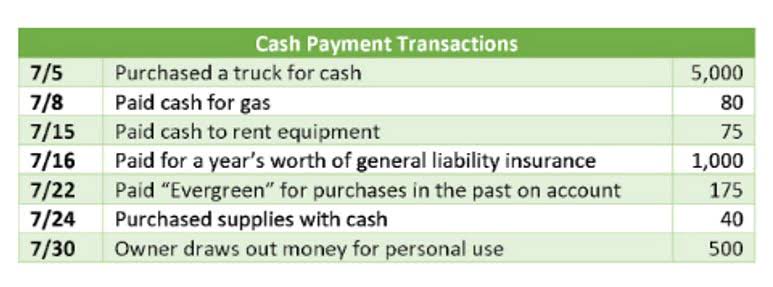
You Bookkeeping for Etsy Sellers might also base your salary on your personal expenses or pay yourself a percentage of your profits. If you are a single-member LLC (meaning, you are the only owner), the IRS will consider the LLC a “disregarded entity” and treat your business as if you were a sole proprietor. The IRS will tax this $40,000 (not the $30,000 you “drew”) as self-employment income so you’ll pay 15.3% tax for FICA. However, you will be able to take a deduction for half of the FICA tax you pay.
- Yet, figuring out how to pay for yourself as a business owner can be complicated.
- Those with a state-specific number of employees must take out a policy.
- Each person should consult his or her own attorney, business advisor, or tax advisor with respect to matters referenced in this post.
- However, the type of income you make from your company is highly dependent on your business tax structure.
- Make sure to keep a paper trail documenting your company’s performance and expenses so you can justify your wages if need be.
- C corporations face double taxation—the corporation pays taxes on its profits, and then shareholders pay taxes again on any dividends received.
You’re our first priority.Every time.
- Running your own business doesn’t mean you sit around as stacks of cash come flooding into your office.
- Single-member LLCs are taxed like sole proprietorships, so they can only take draws.
- In fact, an owner can take a draw of all contributions and earnings from prior years.
- Like a salary, a guaranteed payment is reported to the partner, and the partner pays income tax on the payment.
- For example, maybe instead of being a sole proprietor, Patty setup Riverside Catering as a corporation.
Partners are the same legal entity as their business, much like the tax entity of sole proprietors. Partnerships are pass-through tax entities, meaning the owners are responsible for paying their share of taxes. If your salary vs draw business structure is any other than a C corporation, you may take an owner’s draw if you own equity in the business. The reason is that pass-through entities show profits on your personal taxes. Understanding the impact of these different tax treatments is vital. A salary can provide a steady income and predictable tax deductions for the business, but it means higher payroll taxes.

Avoiding tax confusion

Electing S Corp instead of sole proprietorship treatment could mean tax savings for some businesses. Generally, you could save taxes as an S Corp if you’re earning more from your business than a typical salary for someone in your field. A tax professional can help you determine the tax implications of each structure and choose the right one for your business. As a sole proprietor, you have to claim all the money you make through your business as personal income, even if only a portion of it goes to personal use.
Profits
You receive consistent paychecks with taxes withheld, just like a traditional adjusting entries job. When it comes to deciding between paying yourself with an owner’s draw and a salary, the biggest thing you need to consider is your business classification. If you’re a service provider, you’ll work with clients as a 1099 employee, also known as an independent contractor. Clients pay you for services, and they don’t pay any taxes on your behalf (the way an employer would). The biggest difference between paying yourself via a draw method versus a salary method is in how they’re taxed.
A Guide to Owner’s Draw and Payroll Implications
While this flexibility can make budgeting difficult, it also allows you to anticipate and adjust to your business’s needs. Easily send repayment data to the bureaus and reduce delinquency rates. If you had a job with another employer in the past, you may remember all the deductions you saw on your paystubs. So now that you know a bit about the different options available, let’s talk about how to factor in your type of business to this equation. So if your company grew by 50% in the past year and your current salary is $70,000, you’d multiply your salary by 150% and come up with your new salary, which is $105,000 (not bad!). Get free guides, articles, tools and calculators to help you navigate the financial side of your business with ease.
Pro tip: How to make an owner’s draw

She could take some or even all of her $80,000 owner’s equity balance out of the business, and the draw amount would reduce her equity balance. To help you decide what’s best for you, we created this small business guide that breaks down the differences between an owner’s draw vs. salary. Now, let’s dive into the nitty-gritty details, including what payment method is best for you and how much to pay yourself as a self-employed business owner. As a sole proprietor, you’ll pay a 15.3% self-employment tax for Medicare and Social Security, plus income tax based on your tax bracket. The latter is determined by your total taxable income for the year, which you can estimate using IRS Form 1040-ES. You don’t report an owner’s draw on your tax return, but you do report all of your business income from which you make the draw.

Many states don’t require sole proprietors to carry workers’ compensation insurance. Those with a state-specific number of employees must take out a policy. If you are a stakeholder who also works for the business entity, check the state guidelines. Some states base workers’ compensation status on ownership percentage. Of course, operating a business without workers’ compensation puts owners-operators at risk. It’s important to keep in mind that an owner’s draw is not actually tax-exempt.
Pros and Cons of Salary vs. Draw for Business Owners
Since Patty is the only owner, her owner’s equity account increases by $30,000 to $80,000. The $30,000 profit is also posted as income on Patty’s personal income tax return. While selecting how to pay yourself is an important decision, it can also be difficult, especially if it’s your first business. Schedule a quick consultation–usually 30 minutes or less to learn more.



Leave A Comment